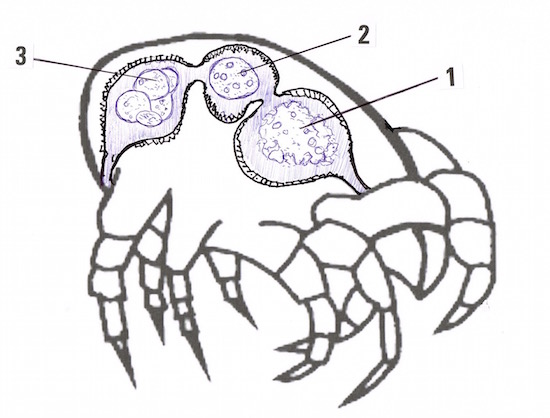Der p23, a dangerous new allergen from house dust mites (HDM)
The newly discovered house dust mite allergen (Der p23) appears to come from cells lining the middle section of the mite multi-chambered gut and is intended to protect the mite from toxic food and be part of the film that encloses mite droppings. Der p23 is a major mite allergen discovered in 2013.
Origin and Function of Der p23
Der p23 is thought to come from epithelial cells in the mite midgut and then be transported by vesicles (sacs) dropping from the cell wall. It is meant to protect the mite from harmful food, aid the mite digestion, and become part of the peritrophic membrane (film) that covers the mite dropping. Once this process is complete the dropping, containing several sections and held together by mucus is expelled from the hindgut.1, 2
Chambered gut of the house dust mite

1. Food held. 2. Der p23 is dropped from cells. 3. Hindgut with wrapped dropping
Within the film Der p23 appears as a peritrophin-like protein that acts to bind together matter such as chitin fibrils and granules. The film itself is a semi-permeable network of fibres that dissolve on contact with moisture.
In terms of allergen importance it ranks alongside Der p1 and Der p2 with over 70% of house dust mite allergy patients allergic to Der p23. The allergen is reported to be an active digestive enzyme.3
The newly discovered Der p23 is one more reason to avoid excessive exposure to house dust mites, a mite recently described as a close relative of the parasitic mange mite, Psoroptes ovis.4, 5, 6
For further research information on the film that covers a house dust mite dropping, please refer to the 1972 paper quoted below.2
The membrane surrounding the food balls in the posterior midgut is 1 to 2 microns thick. The inner and outer margins of the membrane appear more electron-dense than the central region. The electron-dense inner margin of the membrane contains numerous granules. The outer wall of the membrane is composed largely of a mat of extremely fine fibrils (approximately 3.5 by 300 nm). The central portion of the membrane contain fewer granules and fibers. In the hindgut, the membrane remains intact and there surrounds a fecal particle. The three to five fecal particles that form a fecal pellet are held together by what appears to be mucus.
Notes: Chitinases, an enzyme that digests chitin, is a known allergen from house dust mites. Chitin forms the outer wall of fungi and was in 1972 thought to be part of the peritrophic membrane encasing the mite's dropping. Fungi are an important food for the mite. Records show that the house dust mite is a 23 million year old animal that survived the dinosaurs.
References
- Identification of Der p23, A Peritrophin-like Protein, as a New Major Dermatophagoides pteronyssinus Allergen Associate with the Peritrophic Matrix of Mite Fecal Pellets. Weghofer M, J. Immunoloy, April 1, 2013, Vol.190, no.7, 3059-3067
- The Peritrophic Membrane of the Mite, Dermatophagoides farinae: Acriformes, J.Parasitology, Wharton GW, Brody AR, 1972,p801-804
- Conversion of Der p23, a New Major House Dust Mite Allergen, into a Hypoallergenic Vaccine. Baneriee S, Weber M, Blatt K, Swoboda I, Focke-Teiki M, Valent P, Valenta R, Vrtala S., Immunol. 2014,192, 4867-4875. Quoted from this paper, three nonallergenic peptides from the C-terminal IgE epitope-containing part of Der p 23 (P4, P5) and P6, a mutant peptide containing serines instead of cysteines, were identified.
- Allergens and their role in the allergic immune response,TAE Platts-Mills, JA Woodfolk, Immunology Reviews, 2011,Vol.242,p51-68
- Is Permanent Parasitism Revesible? Critical Evidence from Early Evolution of House Dust Mites, Klimov PB, O Connor B, Oxford University Press on behalf of the Society of Systemic Biologists (2013)
- Sheep Scab, Psoroptes ovis, The Centre for Food Security and Public Health, Iowa State University, 2009, on line